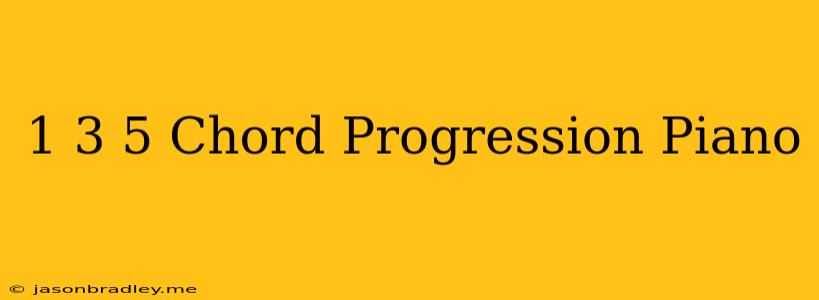The 1-3-5 Chord Progression: A Foundation for Piano Harmony
The 1-3-5 chord progression is a fundamental building block in music theory and is often considered the most basic and common progression in western music. It's a simple yet effective tool used in countless songs across various genres. This progression provides a satisfying sense of resolution and is incredibly versatile for creating various musical styles.
Understanding the Basics
The 1-3-5 chord progression refers to playing three chords in a specific order:
- Chord 1 (I): This is the root chord, representing the key of the song. It's a major chord built on the first note of the scale.
- Chord 3 (III): This is the major chord built on the third note of the scale, often referred to as the major third.
- Chord 5 (V): This is the major chord built on the fifth note of the scale, often referred to as the perfect fifth.
Example in C Major:
- Chord 1 (C Major): C-E-G
- Chord 3 (E Major): E-G#-B
- Chord 5 (G Major): G-B-D
Why it Works
The 1-3-5 chord progression works so well because of the relationships between the chords. The 3rd and 5th chords contain notes that resolve harmonically to the root chord. This creates a sense of stability and completion, making the progression sound satisfying and natural.
Playing the Progression
Here's a simple way to play the 1-3-5 progression on the piano:
- Start with the root chord. For C major, place your fingers on C, E, and G.
- Move to the third chord. Shift your hand to E, G#, and B.
- Finish with the fifth chord. Shift your hand again to G, B, and D.
Variations and Applications
While the basic 1-3-5 progression is straightforward, it can be explored in many ways:
- Inversions: Play the chords in different inversions (root position, first inversion, second inversion).
- Rhythm: Experiment with different rhythms and time signatures.
- Key Changes: Modulate to different keys to create more complex progressions.
- Adding 7th chords: Introduce 7th chords to create a more sophisticated sound.
- Using Suspensions: Add tension by introducing suspended chords (sus2 or sus4).
Examples in Popular Music
You can find this progression in countless songs, ranging from classic pop and rock to jazz and classical music. Here are some examples:
- "Amazing Grace": A timeless hymn that uses the 1-3-5 progression in its melody.
- "House of the Rising Sun": A folk song that features the 1-3-5 progression in its chord structure.
- "Imagine" by John Lennon: The song starts with a 1-3-5 progression.
Conclusion
The 1-3-5 chord progression is an essential tool for any musician, especially pianists. Its simplicity, versatility, and satisfying resolution make it a timeless foundation for creating music across genres. Whether you're a beginner learning the basics or a seasoned musician looking for inspiration, exploring the 1-3-5 progression can lead to endless creative possibilities.
